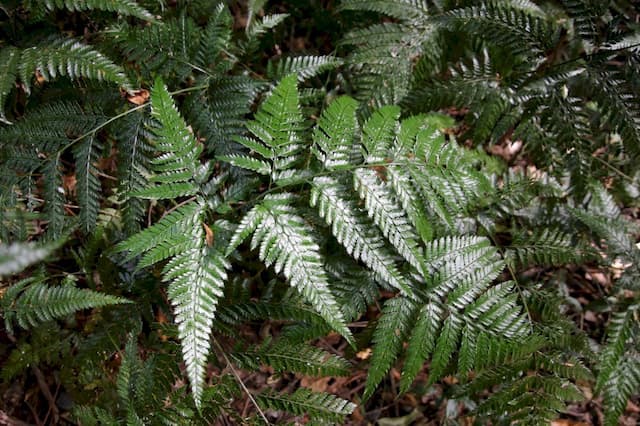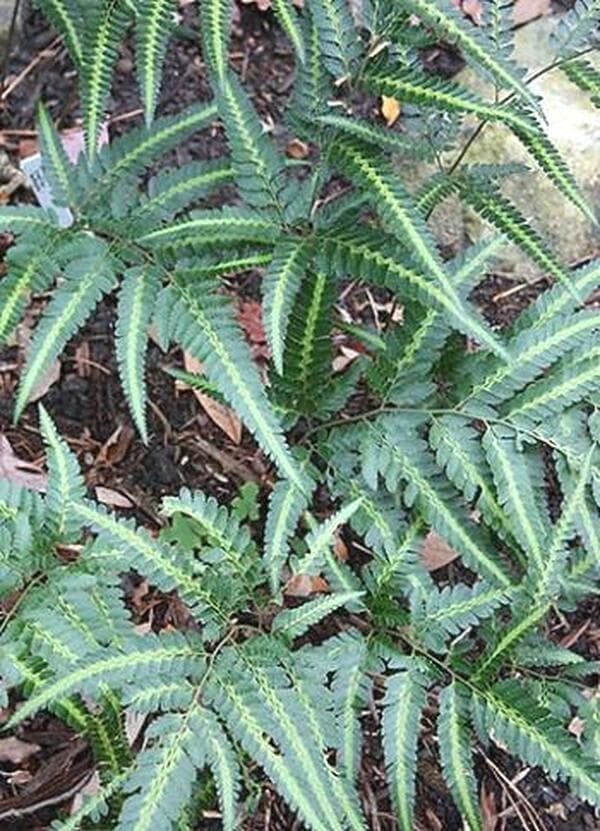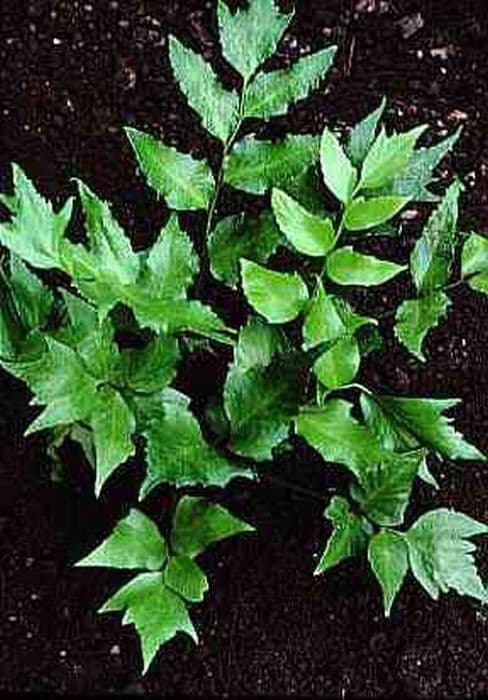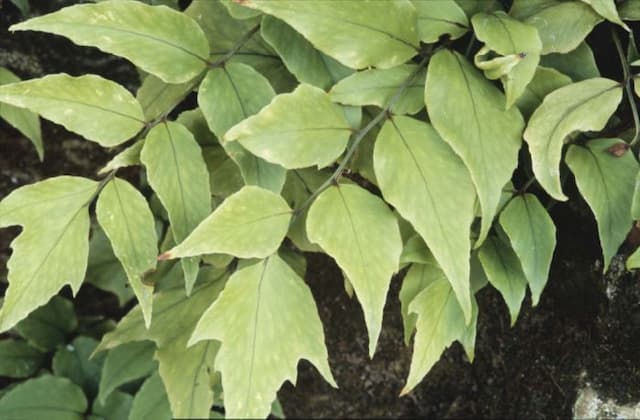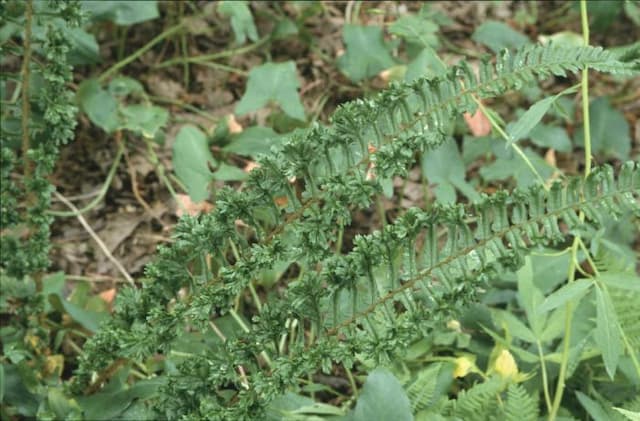Remote Wood Fern Dryopteris × remota

ABOUT
Dryopteris × remota, commonly known as the remote wood fern, is a hybrid fern species characterized by its delicate and lush appearance. The fronds of the remote wood fern are typically a deep green color and exhibit a feathery structure, which contributes to the plant's elegant and graceful silhouette. Each frond radiates outwards from a central point, forming an almost circular shape that appears symmetrical and balanced. The fronds of the remote wood fern are divided into smaller leaflets, known as pinnae, which are themselves subdivided into even smaller segments called pinnules. These pinnules have smooth or slightly toothed edges, giving the fronds a finely textured look. The overall structure of the fronds is orderly, yet the individual pinnules may have a slightly ruffled or crinkled appearance, adding to the fern's ornate beauty. The middle of the frond, or the rachis, is typically a lighter color than the leaflets, sometimes showing a slight contrast against the deep green of the pinnae. As a terrestrial plant, the remote wood fern possesses a rhizome from which the fronds uncurl in a classic fiddlehead fashion during the spring, a characteristic common among ferns. The backside of the fronds may display the reproductive structures of the fern, called sori. These appear as small, rounded spots or clusters where the plant's spores are housed. In terms of texture, the remote wood fern is relatively soft and lacks the stiffness found in some other fern species. This softness contributes to the plant's soothing visual appeal. As a hybrid species, it exhibits a blend of features from its parent plants, resulting in the beautiful and remote wood fern often admired in gardens and natural settings for its elegance and understated charm.
About this plant
 Names
NamesFamily
Dryopteridaceae
Synonyms
Remote Wood Fern, Scaly Male Fern
Common names
Dryopteris remota, Aspidium remotum
 Toxicity
ToxicityTo humans
The plant Dryopteris × remota, commonly known as remote wood fern, is not considered highly toxic to humans. There is little to no information suggesting that it has severe toxic effects when touched or ingested by people. However, like many ferns, it may cause mild digestive discomfort if ingested in large quantities. In general, it is not advisable to eat any part of ornamental plants due to the potential for mild gastrointestinal symptoms such as nausea, vomiting, or diarrhea.
To pets
The remote wood fern (Dryopteris × remota) is not typically known to be toxic to pets. While it may not be specifically listed as a poisonous plant for pets like dogs and cats, it is still a good practice to prevent pets from ingesting plants. Some ferns can cause mild gastrointestinal upset if ingested, so symptoms could potentially include vomiting, diarrhea, or abdominal pain. Always consult with a veterinarian if you have concerns about a pet that has ingested any part of a plant.
 Characteristics
CharacteristicsLife cycle
Perennials
Foliage type
Deciduous
Color of leaves
Green
Height
3 feet (91 cm)
Spread
3 feet (91 cm)
Plant type
Fern
Hardiness zones
5
Native area
Europe
Benefits
 General Benefits
General Benefits- Ecosystem Support: Provides habitat and food for insects, birds, and other wildlife.
- Soil Stability: Helps prevent soil erosion with its root system.
- Landscape Aesthetics: Adds greenery and natural beauty to gardens and landscapes.
- Biodiversity: Contributes to plant diversity in forest ecosystems.
- Local Climate Regulation: Contributes to local humidity and temperature regulation through transpiration and shade provision.
 Medical Properties
Medical PropertiesThis plant is not used for medical purposes.
 Air-purifying Qualities
Air-purifying QualitiesThis plant is not specifically known for air purifying qualities.
 Other Uses
Other Uses- Ecological Indicator: Dryopteris remota can be used to indicate rich, undisturbed woodlands, as it is often found in these habitats.
- Natural Mulch: Dead fronds can be left to decompose naturally, providing nutrient-rich mulch for soil organisms and nearby plants.
- Bioindicator of Soil pH: The presence and health of D. remota can give clues about the soil pH, as it prefers neutral to slightly acidic conditions.
- Education and Research: It is used for botanical studies to educate about fern life cycles and reproduction since it is a hybrid with unique characteristics.
- Shade Garden Enhancement: Its lush foliage can be used to create contrast and depth in shaded garden designs.
- Erosion Control: The root system can help stabilize soil in shady areas where erosion might be a problem.
- Craft Material: Dried fronds can be used in floral arrangements or as part of craft projects for their intricate leaf patterns.
- Companion Planting: It can be planted alongside other shade-loving plants to create a diverse understory ecosystem in woodland gardens.
- Habitat Provision: It offers habitat and shelter for various insects and small wildlife within a garden or woodland setting.
- Environmental Education: D. remota is utilized in environmental programs to demonstrate the importance of preserving forest understory flora.
Interesting Facts
 Feng Shui
Feng ShuiThe Remote Wood Fern is not used in Feng Shui practice.
 Zodiac Sign Compitability
Zodiac Sign CompitabilityThe Remote Wood Fern is not used in astrology practice.
 Plant Symbolism
Plant Symbolism- Resilience: Dryopteris × remota, commonly known as the Remote Wood Fern, can thrive in various environments, symbolizing the ability to adapt and recover from challenges.
- Endurance: As a fern that returns each year even after die-back in winter, it represents endurance and the capacity to withstand difficult conditions over time.
- Shelter: The dense foliage of the Remote Wood Fern provides shelter to small creatures, thus symbolizing protection and a safe haven.
- Secretive: Ferns have a long history of being associated with secrecy and discreetness, partly due to their quiet habitats in forested areas.
- Agelessness: Ferns are ancient plants, and their presence in a garden can symbolize the timeless nature of an entity or the wisdom of age.
 Water
WaterThe Remote Wood Fern should be watered regularly, ensuring that the soil is consistently moist but not waterlogged. Watering should be done deeply, with approximately 1 gallon for a mature fern, every week during the growing season. The amount of water may need to be adjusted if the plant is in a particularly dry environment or during extreme heat. In the winter, water less frequently, allowing the top layer of soil to dry out slightly between waterings.
 Light
LightThe Remote Wood Fern thrives best in partial to full shade conditions. It should be kept in a spot where it's protected from the harsh afternoon sun, while still receiving some dappled sunlight or indirect light throughout the day. An ideal location would be under the canopy of trees or on the north side of a building where it gets filtered light.
 Temperature
TemperatureThe Remote Wood Fern prefers cool to moderate temperatures and can survive between 50°F and 75°F for optimal growth. The fern is hardy and can withstand temperatures as low as 40°F, but it should be protected from frost. The ideal temperature range for the Remote Wood Fern to thrive is between 60°F and 70°F.
 Pruning
PruningPruning the Remote Wood Fern typically involves removing dead or damaged fronds to maintain its appearance and health. Prune in the spring before new growth starts, as this is the best time to see which fronds are not coming back. This fern seldom needs extensive pruning; just snip away the fronds that are brown and withered. Pruning once a year should be sufficient.
 Cleaning
CleaningAs needed
 Soil
SoilThe Remote Wood Fern thrives best in a soil mix consisting of two parts peat and one part perlite or coarse sand, ensuring good drainage and aeration. The optimal soil pH for the Remote Wood Fern should be slightly acidic to neutral, ranging from 5.5 to 7.0.
 Repotting
RepottingThe Remote Wood Fern should be repotted every 2-3 years to refresh the soil and accommodate root growth. Choose a slightly larger pot to allow space for continued development.
 Humidity & Misting
Humidity & MistingThe Remote Wood Fern prefers high humidity levels, ideally between 60% to 80%, to mimic its natural forest habitat. Consistently high humidity is crucial for its wellbeing.
 Suitable locations
Suitable locationsIndoor
Place Remote Wood Fern in indirect light with high humidity.
Outdoor
Plant Remote Wood Fern in shade with moist soil.
Hardiness zone
5-9 USDA
 Life cycle
Life cycleThe Remote Wood Fern (Dryopteris × remota) begins its life cycle as a spore, which germinates under appropriate moisture and temperature conditions to form a tiny, heart-shaped gametophyte, a haploid stage that supports sexual reproduction. The gametophyte produces male and female gametes, with fertilization occurring when conditions allow for the sperm to swim to an egg. Upon fertilization, a new diploid sporophyte forms, initially as a small, green shoot, which will grow into the mature fern. This sporophyte phase is the most recognizable, featuring fronds that unfurl from tightly coiled fiddleheads as they mature. The mature fern produces spores on the undersides of its fronds in structures called sori, usually visible as brown or yellowish spots, completing the reproductive cycle. Over time, the fern can spread and form larger clumps through rhizomatous growth, thus expanding its presence in the understory of forests or shaded garden environments.
 Propogation
PropogationPropogation time
Spring-early summer
Propogation: The plant Dryopteris × remota, commonly known as the Remote Wood Fern, is typically propagated through spore collection and sowing. Spore propagation is the most popular method used for ferns like the Remote Wood Fern due to the absence of seeds or easy division methods applicable to other plants. To propagate by spores, one must collect ripe spores from the undersides of the fronds when they are mature, usually in late summer. These spores should then be sown on the surface of a sterile, moist potting mix in a shallow tray. The tray needs to be covered with clear plastic to maintain high humidity and placed in indirect light. Germination occurs over several weeks to months, and once the sporelings are large enough, they can be carefully transplanted into individual pots or their final location.




